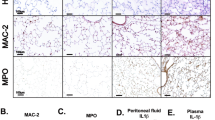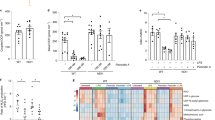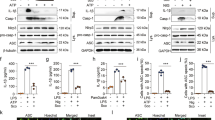Abstract
Altered metabolism has been implicated in the pathogenesis of inflammatory diseases. NADPH oxidase 4 (NOX4), a source of cellular superoxide anions, has multiple biological functions that may be of importance in inflammation and in the pathogenesis of human metabolic diseases, including diabetes. However, the mechanisms by which NOX4-dependent metabolic regulation affect the innate immune response remain unclear. Here we show that deficiency of NOX4 resulted in reduced expression of carnitine palmitoyltransferase 1A (CPT1A), which is a key mitochondrial enzyme in the fatty acid oxidation (FAO) pathway. The reduced FAO resulted in less activation of the nucleotide-binding domain, leucine-rich-repeat-containing receptor (NLR), pyrin-domain-containing 3 (NLRP3) inflammasome in human and mouse macrophages. In contrast, NOX4 deficiency did not inhibit the activation of the NLR family, CARD-domain-containing 4 (NLRC4), the NLRP1 or the absent in melanoma 2 (AIM2) inflammasomes. We also found that inhibition of FAO by etomoxir treatment suppressed NLRP3 inflammasome activation. Furthermore, Nox4-deficient mice showed substantial reduction in caspase-1 activation and in interleukin (IL)-1β and IL-18 production, and there was improved survival in a mouse model of NLRP3-mediated Streptococcus pneumoniae infection. The pharmacologic inhibition of NOX4 by either GKT137831, which is currently in phase 2 clinical trials, or VAS-2870 attenuated NLRP3 inflammasome activation. Our results suggest that NOX4-mediated FAO promotes NLRP3 inflammasome activation.
This is a preview of subscription content, access via your institution
Access options
Subscribe to this journal
Receive 12 print issues and online access
$209.00 per year
only $17.42 per issue
Buy this article
- Purchase on Springer Link
- Instant access to full article PDF
Prices may be subject to local taxes which are calculated during checkout






Similar content being viewed by others
Change history
24 November 2023
This article has been retracted. Please see the Retraction Notice for more detail: https://doi.org/10.1038/s41591-023-02723-8
References
Sutterwala, F.S. et al. Critical role for NALP3 (CIAS1 or cryopyrin) in innate and adaptive immunity through its regulation of caspase-1. Immunity 24, 317–327 (2006).
Franchi, L., Eigenbrod, T., Muñoz-Planillo, R. & Nuñez, G. The inflammasome: a caspase-1-activation platform that regulates immune responses and disease pathogenesis. Nat. Immunol. 10, 241–247 (2009).
Hotamisligil, G.S. Inflammation and metabolic disorders. Nature 444, 860–867 (2006).
Wen, H. et al. Fatty acid–induced NLRP3–ASC inflammasome activation interferes with insulin signaling. Nat. Immunol. 12, 408–415 (2011).
Youm, Y.H. et al. The ketone metabolite β-hydroxybutyrate blocks NLRP3 inflammasome-mediated inflammatory disease. Nat. Med. 21, 263–269 (2015).
Moon, J.S. et al. mTORC1-induced HK1-dependent glycolysis regulates NLRP3 inflammasome activation. Cell Rep. 12, 102–115 (2015).
Moon, J.S. et al. UCP2-induced fatty acid synthase promotes NLRP3 inflammasome activation during sepsis. J. Clin. Invest. 125, 665–680 (2015).
Vandanmagsar, B. et al. The NLRP3 inflammasome instigates obesity-induced inflammation and insulin resistance. Nat. Med. 17, 179–188 (2011).
Carracedo, A., Cantley, L.C. & Pandolfi, P.P. Cancer metabolism: fatty acid oxidation in the limelight. Nat. Rev. Cancer 13, 227–232 (2013).
Currie, E., Schulze, A., Zechner, R., Walther, T.C. & Farese, R.V. Jr. Cellular fatty acid metabolism and cancer. Cell Metab. 18, 153–161 (2013).
Rasmussen, B.B. et al. Malonyl coenzyme A and the regulation of functional carnitine palmitoyltransferase 1 activity and fat oxidation in human skeletal muscle. J. Clin. Invest. 110, 1687–1693 (2002).
McGarry, J.D., Mills, S.E., Long, C.S. & Foster, D.W. Observations on the affinity for carnitine, and malonyl-CoA sensitivity, of carnitine palmitoyltransferase 1 in animal and human tissues. Demonstration of the presence of malonyl-CoA in nonhepatic tissues of the rat. Biochem. J. 214, 21–28 (1983).
Drummond, G.R., Selemidis, S., Griendling, K.K. & Sobey, C.G. Combating oxidative stress in vascular disease: NADPH oxidases as therapeutic targets. Nat. Rev. Drug Discov. 10, 453–471 (2011).
Hecker, L. et al. NADPH oxidase 4 mediates myofibroblast activation and fibrogenic responses to lung injury. Nat. Med. 15, 1077–1081 (2009).
Weyemi, U. et al. ROS-generating NADPH oxidase NOX4 is a critical mediator in oncogenic H-Ras-induced DNA damage and subsequent senescence. Oncogene 31, 1117–1129 (2012).
Geiszt, M., Kopp, J.B., Várnai, P. & Leto, T.L. Identification of renox, an NAD(P)H oxidase in kidney. Proc. Natl. Acad. Sci. USA 97, 8010–8014 (2000).
Goettsch, C. et al. NADPH oxidase 4 limits bone mass by promoting osteoclastogenesis. J. Clin. Invest. 123, 4731–4738 (2013).
Cheng, G., Cao, Z., Xu, X., van Meir, E.G. & Lambeth, J.D. Homologs of gp91phox: cloning and tissue expression of Nox3, Nox4 and Nox5. Gene 269, 131–140 (2001).
Block, K., Gorin, Y. & Abboud, H.E. Subcellular localization of Nox4 and regulation in diabetes. Proc. Natl. Acad. Sci. USA 106, 14385–14390 (2009).
Kuroda, J. et al. NADPH oxidase 4 (Nox4) is a major source of oxidative stress in the failing heart. Proc. Natl. Acad. Sci. USA 107, 15565–15570 (2010).
Gorin, Y. et al. Nox4 NAD(P)H oxidase mediates hypertrophy and fibronectin expression in the diabetic kidney. J. Biol. Chem. 280, 39616–39626 (2005).
Witzenrath, M. et al. The NLRP3 inflammasome is differentially activated by pneumolysin variants and contributes to host defense in pneumococcal pneumonia. J. Immunol. 187, 434–440 (2011).
McNeela, E.A. et al. Pneumolysin activates the NLRP3 inflammasome and promotes proinflammatory cytokines independently of TLR4. PLoS Pathog. 6, e1001191 (2010).
Assaily, W. et al. ROS-mediated p53 induction of Lpin1 regulates fatty acid oxidation in response to nutritional stress. Mol. Cell 44, 491–501 (2011).
Susztak, K., Ciccone, E., McCue, P., Sharma, K. & Böttinger, E.P. Multiple metabolic hits converge on CD36 as novel mediator of tubular epithelial apoptosis in diabetic nephropathy. PLoS Med. 2, e45 (2005).
Huynh, F.K., Green, M.F., Koves, T.R. & Hirschey, M.D. Measurement of fatty acid oxidation rates in animal tissues and cell lines. Methods Enzymol. 542, 391–405 (2014).
Mensink, R.P. Effects of stearic acid on plasma lipid and lipoproteins in humans. Lipids 40, 1201–1205 (2005).
Pandolfi, P.P. et al. Targeted disruption of the housekeeping gene encoding glucose 6-phosphate dehydrogenase (G6PD): G6PD is dispensable for pentose synthesis but essential for defense against oxidative stress. EMBO J. 14, 5209–5215 (1995).
Lu, A. et al. Unified polymerization mechanism for the assembly of ASC-dependent inflammasomes. Cell 156, 1193–1206 (2014).
Yu, J.W. et al. Cryopyrin and pyrin activate caspase-1, but not NF-κB, via ASC oligomerization. Cell Death Differ. 13, 236–249 (2006).
McGarry, J.D. & Brown, N.F. The mitochondrial carnitine palmitoyltransferase system. From concept to molecular analysis. Eur. J. Biochem. 244, 1–14 (1997).
Varanasi, U. et al. Isolation of the human peroxisomal acyl-CoA oxidase gene: organization, promoter analysis and chromosomal localization. Proc. Natl. Acad. Sci. USA 91, 3107–3111 (1994).
Muñoz-Planillo, R. et al. K+ efflux is the common trigger of NLRP3 inflammasome activation by bacterial toxins and particulate matter. Immunity 38, 1142–1153 (2013).
Ashcroft, F.M. ATP-sensitive potassium channelopathies: focus on insulin secretion. J. Clin. Invest. 115, 2047–2058 (2005).
Trnka, J., Blaikie, F.H., Logan, A., Smith, R.A. & Murphy, M.P. Antioxidant properties of MitoTEMPOL and its hydroxylamine. Free Radic. Res. 43, 4–12 (2009).
Tran, M. et al. PGC-1α promotes recovery after acute kidney injury during systemic inflammation in mice. J. Clin. Invest. 121, 4003–4014 (2011).
Tutwiler, G.F., Brentzel, H.J. & Kiorpes, T.C. Inhibition of mitochondrial carnitine palmitoyl transferase A in vivo with methyl 2-tetradecylglycidate (methyl palmoxirate) and its relationship to ketonemia and glycemia. Proc. Soc. Exp. Biol. Med. 178, 288–296 (1985).
Aoyama, T. et al. Nicotinamide adenine dinucleotide phosphate oxidase in experimental liver fibrosis: GKT137831 as a novel potential therapeutic agent. Hepatology 56, 2316–2327 (2012).
Boden, G. & Shulman, G.I. Free fatty acids in obesity and type 2 diabetes: defining their role in the development of insulin resistance and beta cell dysfunction. Eur. J. Clin. Invest. 32 (Suppl. 3), 14–23 (2002).
Karpe, F., Dickmann, J.R. & Frayn, K.N. Fatty acids, obesity and insulin resistance: time for a re-evaluation. Diabetes 60, 2441–2449 (2011).
Choi, A.M. & Nakahira, K. Dampening insulin signaling by an NLRP3 'meta-flammasome'. Nat. Immunol. 12, 379–380 (2011).
Mihaylova, M.M. & Shaw, R.J. The AMPK signaling pathway coordinates cell growth, autophagy and metabolism. Nat. Cell Biol. 13, 1016–1023 (2011).
Wanders, R.J., Ruiter, J.P., IJLst, L., Waterham, H.R. & Houten, S.M. The enzymology of mitochondrial fatty acid β-oxidation and its application to follow-up analysis of positive neonatal-screening results. J. Inherit. Metab. Dis. 33, 479–494 (2010).
Herrero, L. et al. Alteration of the malonyl-CoA–carnitine palmitoyltransferase 1 interaction in the beta cell impairs glucose-induced insulin secretion. Diabetes 54, 462–471 (2005).
Nolan, C.J., Madiraju, M.S., Delghingaro-Augusto, V., Peyot, M.L. & Prentki, M. Fatty acid signaling in the beta cell and insulin secretion. Diabetes 55 (Suppl. 2), S16–S23 (2006).
Roden, M. Mechanisms of disease: hepatic steatosis in type 2 diabetes—pathogenesis and clinical relevance. Nat. Clin. Pract. Endocrinol. Metab. 2, 335–348 (2006).
Brookheart, R.T., Michel, C.I. & Schaffer, J.E. As a matter of fat. Cell Metab. 10, 9–12 (2009).
Lagathu, C. et al. Long-term treatment with interleukin-1β induces insulin resistance in murine and human adipocytes. Diabetologia 49, 2162–2173 (2006).
Larsen, C.M. et al. Interleukin-1-receptor antagonist in type 2 diabetes mellitus. N. Engl. J. Med. 356, 1517–1526 (2007).
Mandrup-Poulsen, T., Pickersgill, L. & Donath, M.Y. Blockade of interleukin 1 in type 1 diabetes mellitus. Nat. Rev. Endocrinol. 6, 158–166 (2010).
Coll, R.C. et al. A small-molecule inhibitor of the NLRP3 inflammasome for the treatment of inflammatory diseases. Nat. Med. 21, 248–255 (2015).
Carnesecchi, S. et al. A key role for NOX4 in epithelial cell death during development of lung fibrosis. Antioxid. Redox Signal. 15, 607–619 (2011).
Nakahira, K. et al. Autophagy proteins regulate innate immune responses by inhibiting the release of mitochondrial DNA mediated by the NALP3 inflammasome. Nat. Immunol. 12, 222–230 (2011).
Acknowledgements
This work was supported by the US National Institutes of Health (grant no. P01 HL108801, R01 HL079904, R01 HL055330; all to A.M.K.C.). We thank E. Finkelsztein for technical assistance.
Author information
Authors and Affiliations
Contributions
J.-S.M., K.N. and A.M.K.C. conceived the study with assistance from S.W.R.; J.-S.M., K.-P.C., G.M.D., M.J.K., M.A.P. and K.T.R. contributed the in vitro experiments; J.-S.M. and H.S.-D. contributed the in vivo experiments; J.-S.M. contributed all in vitro and in vivo experiments; K.-P.C. contributed the experiments for ASC oligomerization and ASC speck formation; M.A.P. contributed the experiments for human subjects; G.M.D. contributed the experiments for the FAO assay; M.J.K. and K.T.R. contributed the experiments for cytokine analysis; J.-S.M., J.-H.Y., K.N., S.W.R. and A.M.K.C. wrote the paper; and A.M.K.C. supervised the entire project.
Corresponding author
Ethics declarations
Competing interests
The authors declare no competing financial interests.
Supplementary information
Supplementary Text and Figures
Supplementary Figures 1–8 (PDF 7666 kb)
About this article
Cite this article
Moon, JS., Nakahira, K., Chung, KP. et al. RETRACTED ARTICLE: NOX4-dependent fatty acid oxidation promotes NLRP3 inflammasome activation in macrophages. Nat Med 22, 1002–1012 (2016). https://doi.org/10.1038/nm.4153
Received:
Accepted:
Published:
Issue Date:
DOI: https://doi.org/10.1038/nm.4153
This article is cited by
-
Analysis of the Immune Response by Standardized Whole-Blood Stimulation with Metabolism Modulation
Phenomics (2024)
-
Effects of dexmedetomidine on A549 non-small cell lung cancer growth in a clinically relevant surgical xenograft model
Scientific Reports (2023)
-
Genetics and Epigenetics in Obesity: What Do We Know so Far?
Current Obesity Reports (2023)
-
Immunometabolism: a new dimension in immunotherapy resistance
Frontiers of Medicine (2023)
-
Diet-induced obesity impairs spermatogenesis: the critical role of NLRP3 in Sertoli cells
Inflammation and Regeneration (2022)



